Douglas B-66 Destroyer
The Douglas B-66 Destroyer is a light bomber that was designed and produced by the American aviation manufacturer Douglas Aircraft Company.
| B-66 Destroyer | |
|---|---|
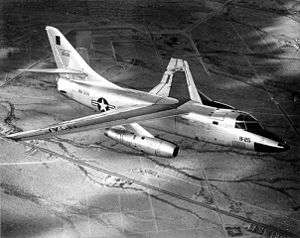 | |
| A Douglas B-66B (53-506) in flight | |
| Role | Light bomber |
| National origin | United States |
| Manufacturer | Douglas Aircraft Company |
| First flight | 28 June 1954 |
| Introduction | 1956 |
| Retired | 1975[1] |
| Primary user | United States Air Force |
| Number built | 294[2] |
| Unit cost |
US$2.55 million (RB-66B)[3] |
| Developed from | Douglas A-3 Skywarrior |
| Developed into | Northrop X-21 |
The B-66 was developed for the United States Air Force (USAF) and is heavily based upon the United States Navy's A-3 Skywarrior, a heavy carrier-based attack aircraft. Originally, officials intended for the aircraft to be a simple development of the earlier A-3, taking advantage of being strictly land-based to dispense with unnecessary naval features. However, due to the USAF producing extensive and substantially divergent requirements, it became necessary to make considerable alterations to the design, leading to a substantial proportion of the B-66 being original rather than derived from the A-3. The B-66 retained the three-man crew arrangement of the US Navy's A-3; differences included the incorporation of ejection seats, which the A-3 had lacked.
Performing its maiden flight on 28 June 1954, the aircraft was introduced to USAF service during 1956. The standard model, designated B-66, was a bomber model that was procured to replace the aging Douglas A-26 Invader; in parallel, a dedicated photo reconnaissance model, designated RB-66, was also produced alongside. Later on, further variants of the type were developed, leading to the aircraft's use in signals intelligence, electronic countermeasures and weather reconnaissance roles. Aircraft would commonly be forward deployed to bases in Europe, where they could more easily approach the airspace of the Soviet Union. Multiple variants would be deployed around Cuba during the Cuban Missile Crisis. They would also see use during the American intervention in the Vietnam War, typically operating as support aircraft for other assets that were active over the skies of North Vietnam. The last examples of the type were withdrawn during 1975.
Design and development
Background
Early on in the United States Navy's A-3 Skywarrior's development, several officials within the United States Air Force (USAF) had been sceptical of the design, some regarding its relatively low take-off weight of 68,000lb as being impossible to achieve.[4] In one instance, USAF general Hoyt Vandenberg ridiculed the proposed A-3 as "making irresponsible claims".[5] This hostile climate may be a result of the A-3 being intended to be operated from the planned United States-class "supercarriers," to which numerous high-ranking officials within the USAF were frequently critical of and were campaigning for the latter's cancellation, which eventually happened.[6]
However, as the flight test program only validated its performance, it was recognised that the A-3 was capable of carrying out the same mission profile of the USAF's much larger Boeing B-47 Stratojet over an unrefuelled combat radius of almost 1,000 miles. Coupled with the development costs having already been paid by the Navy, the cost and performance of a land-based A-3 derivative was quite promising, especially in light of the USAF's pressing needs from the Korean War.[4] Accordingly, during the early 1950s, the service openly expressed interest in procuring its own version of the A-3 to perform land-based missions for the USAF.[4]
Redesign
USAF officials had originally intended the conversion to be a relatively straightforward matter of removing the carrier-specific features and fitting USAF avionics, but otherwise adhering as closely as possible to the original A-3 design.[4] For this reason, no prototypes were ordered when the USAF issued its contract to Douglas in June 1952, instead having opted for five pre-production RB-66A models to be supplied, the aerial reconnaissance mission being considered to be a high priority for the type. However, this contract would be amended, involving multiple new variants that were added and swapped about.[4] Likewise, the list of modifications sought quickly expanded; to meet the changing requirements, the supposedly easy conversion would become what was essentially an entirely new aircraft.[4]
A percentage of the changes made were a result of the USAF's requirement for the B-66 to perform low-level operations, the complete opposite of the US Navy's A-3, which had been developed and operated as a high-altitude nuclear strike bomber. However, aviation authors Bill Gunston and Peter Gilchrist attribute many of the design changes to have been made "merely to be different", being driven by an intense rivalry between the two services; they conclude that "an objective assessment might conclude that 98 per cent of the changes introduced in the RB-66A were unnecessary".[7] Both the fuselage and wing were entirely redesigned from scratch, rather than simply de-navalised.[8] The A-3 was powered by a pair of Pratt & Whitney J57 turbojet engines, whereas the B-66 used two Allison J71 engines; Gunston and Gilchrist note that this engine swap "offered no apparent advantage", generating less thrust and being more fuel-hungry than the J57 engine which was also already in USAF use.[8]
Due to the engine change, this necessitated a complete redesign of the power systems as well, repositioning all hydraulic pumps and generators onto the engines themselves instead of being fed with bleed air from within the fuselage.[8] The pressurized crew compartment was given a different structure, adopting a very deep glazed front position for the pilot. The landing gear was also redesigned, even implementing a completely different door geometry.[9] An impactful difference was the decision to equip the B-66 with ejection seats, a feature which the A-3 had lacked entirely.[8] Aviation authors Bill Gunston and Peter Gilchrist observe of the B-66 that: "The history of the aviation is sprinkled with aircraft which, to save money, were intended to be merely a modified version of an existing type. In very few cases it actually happened like this... the B-66 is a classic example".[4]
Into flight
On 28 June 1954, the first of the RB-66A pre-production aircraft conducted its maiden flight, development being only slightly behind schedule despite the substantial redesign work involved.[10] The test program conducted with the five pre-production aircraft heavily contributed to improvements introduced upon the subsequent production aircraft. On 4 January 1955, the first production B-66B aircraft, which featured an increased gross weight and numerous other refinements, performed its first flight.[10] Deliveries of the B-66B commenced on 16 March 1956. However, the USAF decided to curtail the bomber variant's procurement, cancelling a further 69 B-66Bs and largely relegating the model for use in various test programs.[10]
Once in service, the aircraft's design proved to be relatively versatile. The principal production model was the RB-66B, which incorporated the bomber version's upgrades.[10] Furthermore, it was either produced or retrofitted into a variety of other versions, including the EB-66, RB-66, and the WB-66. Likewise, many variants of the US Navy's A-3 Skywarrior were also produced.
Operational history
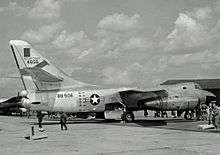
During 1956, deliveries to the USAF commenced. A total of 145 RB-66Bs would be produced. In service, the RB-66 would function as the primary night photo-reconnaissance aircraft of the USAF during this period; accordingly, many examples served with tactical reconnaissance squadrons based overseas, typically being stationed in the United Kingdom and West Germany. A total of 72 of the B-66B bomber version were built, 69 fewer aircraft than had been originally planned. A total of 13 B-66B aircraft later were modified into EB-66B electronic countermeasures (ECM) aircraft, which played a forward role in the Cold War between the United States and the Soviet Union, and were stationed at RAF Chelveston with the 42nd Tactical Reconnaissance Squadron, who performed the conversion during the early 1960s. They would rotate out of an alert pad in [France] during the time that the 42nd had them.
These aircraft, along with the RB-66Cs that the 42nd received, would subsequently see combat service during the Vietnam War. Unlike the US Navy's A-3 Skywarrior, which performed bombing missions in the theatre, the Destroyer was never once used to perform bombing missions in Vietnam.
The RB-66C was a specialized electronic reconnaissance and electronic countermeasures (ECM) aircraft; according to Gunston and Gilchrist, it was the first aircraft designed from the onset for electronic intelligence (ELINT) missions.[1] It was operated by an expanded crew of seven, which included the additional electronics warfare specialists. A total of 36 of these aircraft were constructed; the additional crew members were housed in the space that was used to accommodate the camera/bomb bay of other variants, these aircraft were outfitted with distinctive wingtip pods that accommodated various receiver antennas, which were also present upon a belly-mounted blister.[1] Several RB-66Cs were operated in the vicinity of Cuba during the Cuban Missile Crisis, they would also be deployed over Vietnam. During 1966, these planes were re-designated as EB-66C.
Unarmed EB-66B, EB-66C and EB-66E aircraft flew numerous missions during the Vietnam War. They helped gather electronic intelligence about North Vietnamese defenses, and provided protection for bombing missions of the Republic F-105 Thunderchiefs by jamming North Vietnamese radar systems. Early on, B-66s flew oval "racetrack" patterns over North Vietnam, but after one B-66 was shot down by a MiG, the vulnerable flights were ordered to fly just outside North Vietnamese air space.
On 10 March 1964, a 19th TRS RB-66C flying on a photo-reconnaissance mission from the Toul-Rosières Air Base in France, was shot down over East Germany by a Soviet Mikoyan-Gurevich MiG-21 after it had crossed over the border due to a compass malfunction. The crew ejected from the aircraft and, following a brief period of detention, were repatriated to the United States.
The final Douglas B-66 variant was the WB-66D weather reconnaissance aircraft; 36 were built.
By 1975, the last EB-66C/E aircraft had been withdrawn from USAF service. Most aircraft were scrapped in place, others were temporarily stored while awaiting eventual scrapping.
Variants
- RB-66A
- (Douglas Model 1326) All-weather photo-reconnaissance variant, five built.
- RB-66B
- (Douglas Model 1329) Variant of the RB-66A with production J71-A-13 engines and higher gross weight, 149 built.
- B-66B
- (Douglas Model 1327A) Tactical bomber variant of the RB-66B, 72 built.
- NB-66B
- One B-66B used for testing and a RB-66B used for F-111 radar trials.
- RB-66C
- Electronic reconnaissance variant of the RB-66B, included an additional compartment for four equipment operators, 36 built.
- EB-66C
- Four RB-66Cs with uprated electronic countermeasures equipment.
- WB-66D
- Electronic weather reconnaissance variant with the crew compartment modified for two observers, 36 built with two later modified to X-21A.
- EB-66E
- Specialized electronic reconnaissance conversion of the B-66B.
Northrop X-21
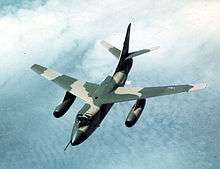
The Northrop X-21 was a modified WB-66D with an experimental wing, designed to conduct laminar flow control studies. Laminar-flow control was thought to potentially reduce drag by as much as 25%. Control would be by removal of a small amount of the boundary-layer air by suction through porous materials, multiple narrow surface slots, or small perforations. Northrop began flight research in April 1963 at Edwards Air Force Base, but with all of the problems encountered, and money going into the war, the X-21 would be the last experiment involving this concept.[11]
Aircraft on display
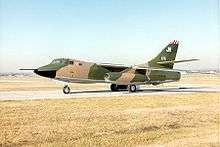
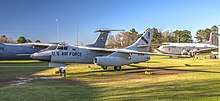
- RB-66B
- 53-0466 – Dyess Linear Air Park, Dyess AFB, Texas.[12]
- 53-0475 – National Museum of the United States Air Force at Wright-Patterson AFB, Ohio.[13]
- RB-66C
- 54-0465 – Shaw AFB, South Carolina.[14]
- WB-66D
Specifications (B-66B)
Data from McDonnell Douglas aircraft since 1920 : Volume I[18]
General characteristics
- Crew: 3 (Pilot, Navigator and EWO)
- Length: 75 ft 2 in (22.91 m)
- Wingspan: 72 ft 6 in (22.10 m)
- Height: 23 ft 7 in (7.19 m)
- Wing area: 780 sq ft (72 m2)
- Empty weight: 42,549 lb (19,300 kg)
- Gross weight: 57,800 lb (26,218 kg)
- Max takeoff weight: 83,000 lb (37,648 kg)
- Powerplant: 2 × Allison J71-A-11 (later Allison J71-A-13) turbojet engines, 10,200 lbf (45 kN) thrust each
Performance
- Maximum speed: 548 kn (631 mph, 1,015 km/h) at 6,000 ft (1,800 m)
- Cruise speed: 459 kn (528 mph, 850 km/h)
- Combat range: 782 nmi (900 mi, 1,448 km)
- Ferry range: 2,146 nmi (2,470 mi, 3,974 km)
- Service ceiling: 39,400 ft (12,000 m)
- Rate of climb: 5,000 ft/min (25 m/s)
- Wing loading: 74.1 lb/sq ft (362 kg/m2)
Armament
- Guns: 2 20 mm M24 cannon in radar-controlled/remotely operated tail turret
- Bombs: 15000 lb (6,800 kg)
Avionics
- APS-27 and K-5 radars
Notable appearances in media
The shooting down of an EB-66 over North Vietnam and the subsequent rescue of one of its crew became the subject for the book Bat*21 by William Charles Anderson, and later a film version (1988) starring Gene Hackman and Danny Glover.
See also
Related development
Aircraft of comparable role, configuration and era
Related lists
References
Citations
- Gunston and Gilchrist 1993, p. 164.
- "Douglas B-66 Destroyer." Archived November 16, 2007, at the Wayback Machine National Museum of the United States Air Force. Retrieved: 5 August 2010.
- Knaack, Marcelle Size. Post-World War II Bombers, 1945-1973. Washington, DC: Office of Air Force History, 1988. ISBN 0-16-002260-6.
- Gunston and Gilchrist 1993, p. 161.
- Gunston and Gilchrist 1993, p. 129.
- Gunston and Gilchrist 1993, p. 128.
- Gunston and Gilchrist 1993, pp. 161-162.
- Gunston and Gilchrist 1993, p. 162.
- Gunston and Gilchrist 1993, pp. 162-163.
- Gunston and Gilchrist 1993, p. 163.
- "B-66 Information." Archived 14 September 2007 at the Wayback Machine B66.info, Retrieved: 5 August 2010.
- "B-66 Destroyer/53-0466." aerialvisuals.ca, Retrieved: 4 June 2015.
- "Douglas RB-66B Destroyer." National Museum of the US Air Force, Retrieved: 24 August 2015.
- "B-66 Destroyer/54-0465." aerialvisuals.ca, Retrieved: 4 June 2015.
- "B-66 Destroyer/55-0390." aerialvisuals.ca, Retrieved: 4 June 2015.
- "B-66 Destroyer/55-0392." Museum of Aviation, Retrieved: 18 December 2017.
- "B-66 Destroyer/55-0395." Pima Air & Space Museum, Retrieved: 4 June 2015.
- Francillon, René J. (1988). McDonnell Douglas aircraft since 1920 : Volume I. London: Naval Institute Press. pp. 498–505. ISBN 0870214284.
Bibliography
- Baugher, Joe. "Douglas B-66 Destroyer." USAAC/USAAF/USAF Bomber Aircraft: Third Series of USAAC/USAAF/USAF Bombers, 2001. Retrieved: 27 July 2006.
- Donald, David and Jon Lake, eds. Encyclopedia of World Military Aircraft. London: AIRtime Publishing, 1996. ISBN 1-880588-24-2.
- Gunston, Bill and Peter Gilchrist. Jet Bombers: From the Messerschmitt Me 262 to the Stealth B-2. Osprey, 1993. ISBN 1-85532-258-7.
- "Douglas RB-66B 'Destroyer'." National Museum of the United States Air Force. Retrieved: 27 July 2006.
- Winchester, Jim, ed. "Douglas A-3 Skywarrior." Military Aircraft of the Cold War (The Aviation Factfile). London: Grange Books plc, 2006. ISBN 1-84013-929-3.